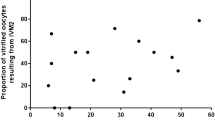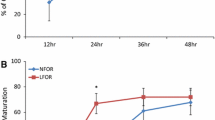Abstract
Purpose
In vitro maturation (IVM) is an alternative to in vitro fertilization (IVF) for women at high risk of developing ovarian hyperstimulation syndrome (OHSS). This study determined the effectiveness and safety of a freeze-only strategy versus fresh embryo transfer (ET) after IVM with a pre-maturation step (CAPA-IVM) in women with a high antral follicle count (AFC).
Methods
This randomized, controlled pilot study (NCT04297553) was conducted between March and November 2020. Forty women aged 18–37 years with a high AFC (≥24 follicles in both ovaries) undergoing one cycle of CAPA-IVM were randomized to a freeze-only strategy with subsequent frozen ET (n = 20) or to fresh ET (n = 20). The primary endpoint was ongoing pregnancy resulting in live birth after the first ET of the started treatment cycle.
Results
The ongoing pregnancy rate in the freeze-only group (65%) was significantly higher than that in the fresh ET group (25%; p = 0.03), as was the live birth rate (60% versus 20%; p = 0.02). Clinical pregnancy rate was numerically, but not significantly, higher after frozen versus fresh ET (70% versus 35%; p = 0.06), while the number of day 3 or good quality embryos, endometrial thickness on the day of oocyte pick-up, implantation rate, and positive pregnancy test rate did not differ significantly between groups. No cases of OHSS were observed, and miscarriage and multiple pregnancy rates were similar in the two groups.
Conclusions
These findings suggest that the effectiveness of CAPA-IVM could be improved considerably by using a freeze-only strategy followed by frozen ET in subsequent cycles.
Trial registration number:
NCT04297553 (www.clinicaltrials.gov)


Similar content being viewed by others
Data availability
The datasets generated and/or analyzed during the current study are not publicly available due to patient privacy but are available from the corresponding author on reasonable request.
References
Child TJ, Abdul-Jalil AK, Gulekli B, Tan SL. In vitro maturation and fertilization of oocytes from unstimulated normal ovaries, polycystic ovaries, and women with polycystic ovary syndrome. Fertil Steril. 2001;76(5):936–42.
Practice Committees of the American Society for Reproductive Medicine, the Society of Reproductive Biologists and Technologists, and the Society for Assisted Reproductive Technology. In vitro maturation: a committee opinion. Fertil Steril. 2021;115(2):298–304. https://doi.org/10.1016/j.fertnstert.2020.11.018.
Paulson RJ, Fauser B, Vuong LTN, Doody K. Can we modify assisted reproductive technology practice to broaden reproductive care access? Fertil Steril. 2016;105(5):1138–43. https://doi.org/10.1016/j.fertnstert.2016.03.013.
Vuong LN, Ho TM, Gilchrist RB, Smitz J. The place of in vitro maturation in assisted reproductive technology. Fertility & Reproduction. 2019;1(01):11–5. https://doi.org/10.1142/s2661318219300022.
Sanchez F, Lolicato F, Romero S, De Vos M, Van Ranst H, Verheyen G, et al. An improved IVM method for cumulus-oocyte complexes from small follicles in polycystic ovary syndrome patients enhances oocyte competence and embryo yield. Human reproduction (Oxford, England). 2017;32(10):2056–68. https://doi.org/10.1093/humrep/dex262.
Vuong LN, Le AH, Ho VNA, Pham TD, Sanchez F, Romero S, et al. Live births after oocyte in vitro maturation with a prematuration step in women with polycystic ovary syndrome. J Assist Reprod Genet. 2020b;37(2):347–57. https://doi.org/10.1007/s10815-019-01677-6.
Gilchrist RB, Luciano AM, Richani D, Zeng HT, Wang X, Vos MD, et al. Oocyte maturation and quality: role of cyclic nucleotides. Reproduction. 2016;152(5):R143–57. https://doi.org/10.1530/rep-15-0606.
Vuong LN, Ho VNA, Ho TM, Dang VQ, Phung TH, Giang NH, et al. In-vitro maturation of oocytes versus conventional IVF in women with infertility and a high antral follicle count: a randomized non-inferiority controlled trial. Human reproduction (Oxford, England). 2020a;35(11):2537–47. https://doi.org/10.1093/humrep/deaa240.
Ho VNA, Pham TD, Le AH, Ho TM, Vuong LN. Live birth rate after human chorionic gonadotropin priming in vitro maturation in women with polycystic ovary syndrome. Journal of ovarian research. 2018;11(1):70. https://doi.org/10.1186/s13048-018-0445-5.
Ortega-Hrepich C, Stoop D, Guzmán L, Van Landuyt L, Tournaye H, Smitz J, et al. A “freeze-all” embryo strategy after in vitro maturation: a novel approach in women with polycystic ovary syndrome? Fertil Steril. 2013;100(4):1002–7. https://doi.org/10.1016/j.fertnstert.2013.06.018.
Walls ML, Hunter T, Ryan JP, Keelan JA, Nathan E, Hart RJ. In vitro maturation as an alternative to standard in vitro fertilization for patients diagnosed with polycystic ovaries: a comparative analysis of fresh, frozen and cumulative cycle outcomes. Human reproduction (Oxford, England). 2015;30(1):88–96. https://doi.org/10.1093/humrep/deu248.
Broekmans FJ, de Ziegler D, Howles CM, Gougeon A, Trew G, Olivennes F. The antral follicle count: practical recommendations for better standardization. Fertil Steril. 2010;94(3):1044–51. https://doi.org/10.1016/j.fertnstert.2009.04.040.
ALPHA, Scientists in Reproductive Medicine, ESHRE Special Interest Group Embryology. Istanbul consensus workshop on embryo assessment: proceedings of an expert meeting. Reprod BioMed Online. 2011;22(6):632–46. https://doi.org/10.1016/j.rbmo.2011.02.001.
Humaidan P, Nelson SM, Devroey P, Coddington CC, Schwartz LB, Gordon K, et al. Ovarian hyperstimulation syndrome: review and new classification criteria for reporting in clinical trials. Human reproduction (Oxford, England). 2016;31(9):1997–2004. https://doi.org/10.1093/humrep/dew149.
Ho VNA, Braam SC, Pham TD, Mol BW, Vuong LN. The effectiveness and safety of in vitro maturation of oocytes versus in vitro fertilization in women with a high antral follicle count. Human reproduction (Oxford, England). 2019;34(6):1055–64. https://doi.org/10.1093/humrep/dez060.
Ortega-Hrepich C, Drakopoulos P, Bourgain C, Van Vaerenbergh I, Guzman L, Tournaye H, et al. Aberrant endometrial steroid receptor expression in in-vitro maturation cycles despite hormonal luteal support: a pilot study. Reprod Biol. 2019;19(2):210–7. https://doi.org/10.1016/j.repbio.2019.06.004.
Blake DA, Proctor M, Johnson NP. The merits of blastocyst versus cleavage stage embryo transfer: a Cochrane review. Human reproduction (Oxford, England). 2004;19(4):795–807. https://doi.org/10.1093/humrep/deh104.
Coskun S, Hollanders J, Al-Hassan S, Al-Sufyan H, Al-Mayman H, Jaroudi K. Day 5 versus day 3 embryo transfer: a controlled randomized trial. Human reproduction (Oxford, England). 2000;15(9):1947–52. https://doi.org/10.1093/humrep/15.9.1947.
Papanikolaou EG, Camus M, Kolibianakis EM, Van Landuyt L, Van Steirteghem A, Devroey P. In vitro fertilization with single blastocyst-stage versus single cleavage-stage embryos. N Engl J Med. 2006;354(11):1139–46. https://doi.org/10.1056/NEJMoa053524.
Papanikolaou EG, D’Haeseleer E, Verheyen G, Van de Velde H, Camus M, Van Steirteghem A, et al. Live birth rate is significantly higher after blastocyst transfer than after cleavage-stage embryo transfer when at least four embryos are available on day 3 of embryo culture. A randomized prospective study. Human reproduction (Oxford, England). 2005;20(11):3198–203. https://doi.org/10.1093/humrep/dei217.
Zech NH, Lejeune B, Puissant F, Vanderzwalmen S, Zech H, Vanderzwalmen P. Prospective evaluation of the optimal time for selecting a single embryo for transfer: day 3 versus day 5. Fertil Steril. 2007;88(1):244–6. https://doi.org/10.1016/j.fertnstert.2006.11.070.
Cohen Y, St-Onge-St-Hilaire A, Tannus S, Younes G, Dahan MH, Buckett W, et al. Decreased pregnancy and live birth rates after vitrification of in vitro matured oocytes. J Assist Reprod Genet. 2018;35(9):1683–9. https://doi.org/10.1007/s10815-018-1216-3.
Smitz JE, Thompson JG, Gilchrist RB. The promise of in vitro maturation in assisted reproduction and fertility preservation. Semin Reprod Med. 2011;29(1):24–37. https://doi.org/10.1055/s-0030-1268701.
Bosdou JK, Venetis CA, Tarlatzis BC, Grimbizis GF, Kolibianakis EM. Higher probability of live-birth in high, but not normal, responders after first frozen-embryo transfer in a freeze-only cycle strategy compared to fresh-embryo transfer: a meta-analysis. Human reproduction (Oxford, England). 2019;34(3):491–505. https://doi.org/10.1093/humrep/dey388.
Roque M, Haahr T, Geber S, Esteves SC, Humaidan P. Fresh versus elective frozen embryo transfer in IVF/ICSI cycles: a systematic review and meta-analysis of reproductive outcomes. Hum Reprod Update. 2019;25(1):2–14. https://doi.org/10.1093/humupd/dmy033.
Chen ZJ, Shi Y, Sun Y, Zhang B, Liang X, Cao Y, et al. Fresh versus frozen embryos for infertility in the polycystic ovary syndrome. N Engl J Med. 2016;375(6):523–33. https://doi.org/10.1056/NEJMoa1513873.
Wei D, Liu JY, Sun Y, Shi Y, Zhang B, Liu JQ, et al. Frozen versus fresh single blastocyst transfer in ovulatory women: a multicentre, randomised controlled trial. Lancet. 2019;393(10178):1310–8. https://doi.org/10.1016/S0140-6736(18)32843-5.
Stormlund S, Sopa N, Zedeler A, Bogstad J, Praetorius L, Nielsen HS, et al. Freeze-all versus fresh blastocyst transfer strategy during in vitro fertilisation in women with regular menstrual cycles: multicentre randomised controlled trial. BMJ. 2020;370:m2519. https://doi.org/10.1136/bmj.m2519.
Shi Y, Sun Y, Hao C, Zhang H, Wei D, Zhang Y, et al. Transfer of fresh versus frozen embryos in ovulatory women. N Engl J Med. 2018;378(2):126–36. https://doi.org/10.1056/NEJMoa1705334.
Vuong LN, Dang VQ, Ho TM, Huynh BG, Ha DT, Pham TD, et al. IVF transfer of fresh or frozen embryos in women without polycystic ovaries. N Engl J Med. 2018;378(2):137–47. https://doi.org/10.1056/NEJMoa1703768.
Practice Committee of the American Society for Reproductive Medicine. Guidance on the limits to the number of embryos to transfer: a committee opinion. Fertil Steril. 2017;107(4):901–3.
Brinsden PR, Wada I, Tan SL, Balen A, Jacobs HS. Diagnosis, prevention and management of ovarian hyperstimulation syndrome. Br J Obstet Gynaecol. 1995;102(10):767–72.
MacDougall MJ, Tan SL, Jacobs HS. In-vitro fertilization and the ovarian hyperstimulation syndrome. Human reproduction (Oxford, England). 1992;7(5):597–600.
Funding
This work was funded by the Vietnam National Foundation for Science and Technology Development (NAFOSTED; grant number FWO.106-YS.2017.02) and by the Fund for Research Flanders (FWO) under grant number G.OD97.18N. The study sponsors were not involved in the study design, the collection, analysis, and interpretation of data, the writing of the report, or the decision to submit the paper for publication. The corresponding author had full access to all the data in the study and had final responsibility to submit for publication.
Author information
Authors and Affiliations
Contributions
LNV, LKN, AHL, HHP. VNAH, HLL, TDP, VQD, THP, JS, and TMH designed the study and monitored data collection. The statistical analysis plan was written by TDP and LNV. Data analysis was conducted by TDP, who acts as guarantor of the data and the analyses. Planning for the first draft of the manuscript was undertaken by LNV, LKN, and TDP. The first draft of the paper was written by LNV. All authors were involved in the decision to publish the paper and in critical revisions of the manuscript. LNV acts as overall guarantor and accepts full responsibility for the work and/or the conduct of the study, had access to the data, and controlled the decision to publish.
Corresponding author
Ethics declarations
Conflict of interest
LNV has received speaker and conference fees from Merck, and grant, speaker, and conference fees from Merck Sharpe & Dohme and Ferring. TMH has received speaker fees from Merck, Merck Sharp & Dohme and Ferring. JS reports lecture fees from Ferring Pharmaceuticals, BioMerieux, Besins Female Healthcare and Merck, grants from Fund for Research Flanders (FWO), and is co-inventor on granted patents on CAPA-IVM methodology in the USA (US10392601B2) and Europe (EP3234112B1).
Additional information
Publisher’s note
Springer Nature remains neutral with regard to jurisdictional claims in published maps and institutional affiliations.
Rights and permissions
About this article
Cite this article
Vuong, L.N., Nguyen, L.K., Le, A.H. et al. Fresh embryo transfer versus freeze-only after in vitro maturation with a pre-maturation step in women with high antral follicle count: a randomized controlled pilot study. J Assist Reprod Genet 38, 1293–1302 (2021). https://doi.org/10.1007/s10815-021-02180-7
Received:
Accepted:
Published:
Issue Date:
DOI: https://doi.org/10.1007/s10815-021-02180-7




